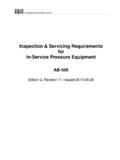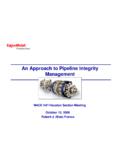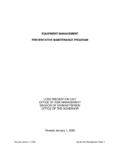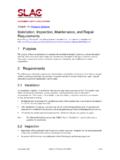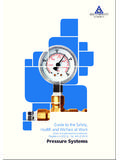Transcription of Implementation of a preventative pressure …
1 Primary Intention Vol. 10 No. 2 May 200261 McErlean B et al. preventative pressure management frameworkImplementation of a preventative pressure management frameworkB McErlean BN J Prendergast S Sandison L Jeffers A Milne J Cotton W HumphreysBeth McErlean BN Grad Dip Nursing Acute CareManagement Support Consultant Nursing Services Repatriation General Hospital Daws Road, Daw Park, SA 5042 Tel: (08) 8276 9666 SummaryThis article describes the quality improvement and audit processes used by one hospital to: examine pressure prevention practices and rates of pressure ulcer development; develop and implement an organisational pressure prevention framework in response to the audit results found; and evaluate the outcomes.
2 The developed framework supports the principles of clinical governance. The early identification of risk is then communicated to all subsequent health care workers, resulting in the Implementation of appropriate preventative interventions. Point prevalence monitoring is the main organisational evaluation mechanism used and, whilst methodological differences existed between the first and subsequent audits, there still remains enough evidence to support the notion that the framework has been successful in achieving its goal.
3 The hospital has seen an increase in the identification of the patient at risk on admission and the Implementation of appropriate preventative interventions; this has led to a reduction in the incidence and severity of pressure ulcers. However, the brief of the working party is not complete. The working party plans to undertake a piece of research in 2002 to validate the risk assessment tool developed and also to develop a mechanism to link the identified risk with the casemix profile of the worldwide move towards clinical governance within hospitals 1.
4 2 and the institution of clinical risk management programmes 3 have served as an impetus for organisations to review processes of care in an endeavour to ensure that standards and practices are based on the most rigorous evidence available and that services produce measurable General Hospital (RGH) is a 250 bed facility which draws approximately 50 per cent of its patients from the community of war veterans and 50 per cent from the general community in the southern metropolitan area of Adelaide.
5 The average patient age at the hospital is 72 and is significantly older than patients of similar casemix in other metropolitan teaching hospitals. It is known that pressure ulcer incidence occurs more often in the elderly 4, 5. preventative pressure management has for many years served as a quality of care indicator, as the development of pressure ulcers is largely felt to be preventable 6, 7. However, pressure ulcer rates continue to be a problem and produce costs to both the individual concerned and the organisation.
6 The cost to the individual can be measured in terms of the resultant pain, decreased mobility and activity, loss of independence and even possibly social isolation 4, 8. The financial costs are also high. Porter and Cooter estimated that 60,000 Australians will develop a pressure ulcer each year 9. The costs of managing a pressure ulcer in Australia for dressings and nursing time range from $61,230 (Stage 5, Torrance classification) 10 to $586 per month for a stage 2 ulcer skin integrity pressure ulcer prevalence/incidence audit in December 2000 clearly indicated a need for nursing services at RGH to closely examine current care practices in relation to pressure ulcer prevention as our incidence/prevalence rates were higher than benchmarks identified in the literature 12-14.
7 Curagel is a sterile, clear hydrogel sheet available from Tyco Healthcare in both adhesive and non-adhesive forms. The unique balanced hydration capabilities of Curagel means that not only can it donate moisture to create an optimal wound - healing enviroment, but it also can absorb excess exudate to reduce the risk of macreation. This means Curagel can be used for a variety of wounds. So for all your balanced hydration dressing needs, look no further than Tyco Healthcare's is available in a wide range of sizes to suit your individual clinical free samples or further information about Curagel contact Tyco Healthcare.
8 Tyco Healthcare Customer Service Australia 1800 252 467 Tyco Healthcare Customer Service New Zealand 0508 489 264using curagelbe hydrated stay hydratedPrimary Intention Vol. 10 No. 2 May 200262 McErlean B et al. preventative pressure management frameworkA working party was commissioned to examine the issues and develop an effective management framework aimed at identifying patients at risk and initiating appropriate treatments to reduce pressure ulcer dataIn December 2000 the stomal therapist and vascular clinical nurse consultant undertook a pressure ulcer prevalence/ incidence audit examining all patients admitted in the hospital on one day.
9 Audit tools included the Braden risk assessment tool, a pressure ulcer severity scale 15, direct observation of the patient s skin and a review of the clinical record and care plan. Verbal consent was obtained prior to all skin inspections and two patients refused (n=216). Whilst no mechanism was in place to monitor inter-rater reliability of the audit staff, the members of the audit team had over 10 years experience in wound assessment. Results demonstrated a per cent prevalence and per cent incidence of pressure ulcer development.
10 It is difficult to compare results between hospitals due to varying casemix profiles; however, prevalence rates in Australian acute public health institutions have been quoted as ranging from per cent 12-14. The incidence rate was calculated by examining admission documentation for reported evidence a lack of documentation of the ulcer on admission to the hospital confirmed that it was hospital acquired. It may be possible that the incidence rate was over-estimated due to the reliance on admission documentation, that is, the ulcer may have been present on admission but not recorded.






